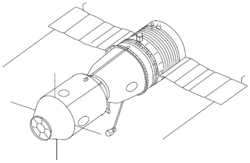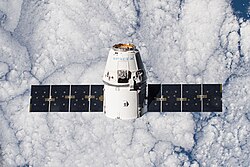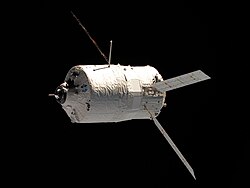Sojuz MS-14
| Sojuz MS-14 (Союз МС-14) | |||
| Beställare | Roskosmos | ||
|---|---|---|---|
| Modell | Sojuz-MS | ||
| Tillverkare | RKK Energia | ||
| Operatör | Roskosmos | ||
| Färdens tid | 15 dag, 17 tim, 45 min | ||
| NSSDC-ID | 2019-055A[1] | ||
| Uppskjutning | |||
| Startplats | Bajkonur 31/6 | ||
| Start | 22 augusti 2019, 03:38 UTC | ||
| Raket | Sojuz-2.1a | ||
| Landning | |||
| Landningsplats | Kazakstan | ||
| Landning | 6 september 2019, 21:32 UTC | ||
| Omloppsbana | |||
| Banlutning | 51,6° | ||
| Dockning | |||
| Rymdstation | ISS | ||
| Dockning | 27 augusti 2019, 03:08 UTC | ||
| Port | Zvezda, akter | ||
| Ur dockning | 6 september 2019, 18:15 UTC | ||
| Tid dockad | 10 dag, 15 tim, 6 min | ||
| Kronologi | |||
| |||
Sojuz MS-14 (ryska: Союз МС-14) var en obemannad flygning i det ryska rymdprogrammet, till Internationella rymdstationen (ISS). Farkosten sköts upp med en Sojuz-2.1a-raket, från Kosmodromen i Bajkonur den 22 augusti 2019.
Målet med flygningen var att testa farkostens räddningsraket i kombination med en Sojuz-2.1a-raket.
Farkosten var även utrustad med ett nytt navigeringssystem, som i framtiden kommer att användas av en obemannad version av Sojuzfarkosten, kallad Sojuz-GVK.
Ombord fanns den ryska roboten Skybot F-850.
Farkosten dockade med rymdstationen den 27 augusti 2019.
Efter att ha lämnat rymdstationen den 6 september 2019 återinträdde den några timmar senare i jordens atmosfär och landade i Kazakstan.
Dockningsförsök
Den 24 augusti 2019 avbröts ett försökt att docka med rymdstationens Pojsk-modul.
Referenser
- Den här artikeln är helt eller delvis baserad på material från engelskspråkiga Wikipedia, Soyuz MS-14, 19 augusti 2019.
Noter
- ^ ”NASA Space Science Data Coordinated Archive” (på engelska). NASA. https://nssdc.gsfc.nasa.gov/nmc/spacecraft/display.action?id=2019-055A. Läst 28 februari 2020.
| |||||||||||||||||||||||||||||||||||||||||||||||||||||||||||||||||||||||||||||||||||||||||
| ||||||||||||||||||||||||||||||||
Media som används på denna webbplats
Soyuz-A manned spacecraft concept (1963). It was to have been part of the Soyuz A-B-C circumlunar complex.
Apollo-Soyuz Test Project (ASTP) Soyuz. The APAS-75 docking unit is located at left.
Soyuz-TM spacecraft. Compare the antennas on the orbital module to those on Soyuz-T. Differences reflect the change from the Igla rendezvous system used on Soyuz-T to the Kurs rendezvous system used on Soyuz-TM.
The Soyuz TMA-04M spacecraft is seen after being rolled out by train to the launch pad at the Baikonur Cosmodrome in Kazakhstan, May 13, 2012. The launch of the Soyuz spacecraft, with Expedition 31 Soyuz Commander Gennady Padalka, Flight Engineer Sergei Revin of Russia and NASA Flight Engineer Joe Acaba, is scheduled for 9:01 a.m., May 15 (Kazakhstan time).
A Progress supply ship linked up to the orbiting International Space Station (ISS) at 3:48 GMT, November 18, bringing Expedition 1 commander William M. Shepherd, pilot Yuri P.
Gidzenko and flight engineer Sergei K. Krikalev two tons of food, clothing, hardware and holiday gifts from their families. The photograph was taken with a 35mm camera and the film was later handed over to the STS-97 crew members
for return to Earth and subsequent processing.Backdropped by a cloud-covered part of Earth, the Orbital Sciences' Cygnus cargo craft approaches the International Space Station, photographed by an Expedition 40 crew member. The two spacecraft converged at 6:36 a.m. (EDT) on July 16, 2014.
ISS021-E-017623 (30 Oct. 2009) --- Backdropped by a cloud-covered part of Earth, the unpiloted Japanese H-II Transfer Vehicle (HTV), filled with trash and unneeded items, departs from the International Space Station. European Space Agency astronaut Frank De Winne, Expedition 21 commander; NASA astronaut Nicole Stott and Canadian Space Agency astronaut Robert Thirsk, both flight engineers, used the station's Canadarm2 robotic arm to grab the HTV cargo craft and unberth it from the Harmony node's nadir port. The HTV was successfully unberthed at 10:18 a.m. (CDT) on Oct. 30, 2009, and released from the station's Canadarm2 at 12:32 p.m.
This image, photographed by one of the Expedition 42 crew members aboard the International Space Station, shows the SpaceX Dragon cargo craft approaching on Jan. 12 2015 for its grapple and berthing and the start of a month attached to the complex. Dragon carried more than 2 ½ tons of supplies and experiments to the station.
ISS026-E-037172 (24 Feb. 2011) --- Surrounded by the blackness of space, the European Space Agency's "Johannes Kepler" Automated Transfer Vehicle-2 (ATV-2) approaches the International Space Station. Docking of the two spacecraft occurred at 10:59 a.m. (EST) on Feb. 24, 2011.
















